Formula One: 1987 Austrian GP
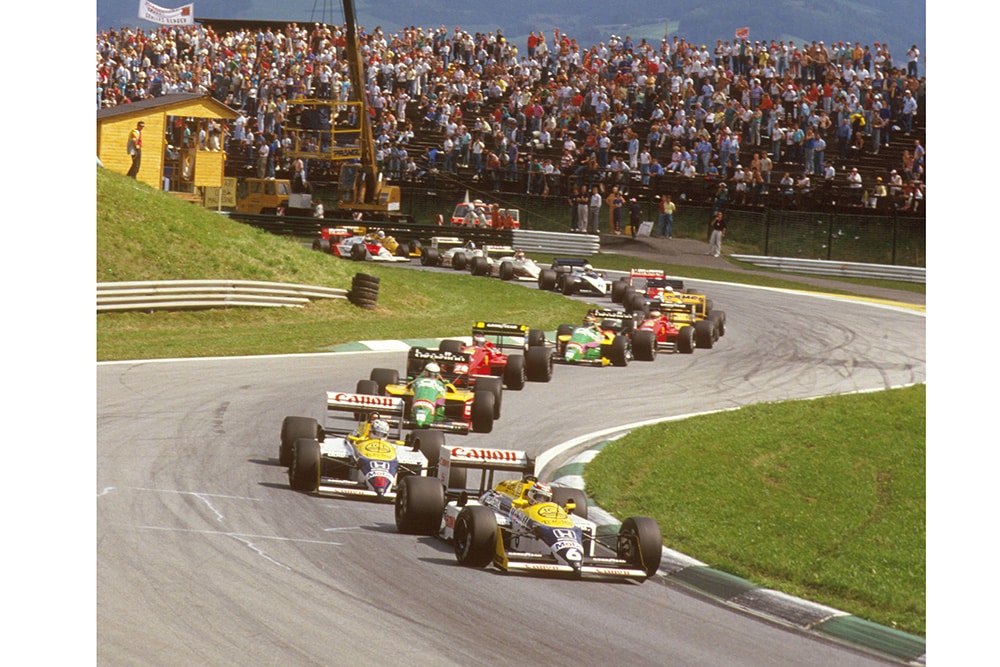
Nelson Piquet leads teammate Nigel Mansell (both Williams FW11B Honda's), Teo Fabi (Benetton B187 Ford) and Gerhard Berger (Ferrari F187) at the start.
© Motorsport Images
Third time lucky
You would expect August 16 to be blazing hot almost anywhere in Europe, but Austria is not like that. On the Thursday before practice began the clouds were down on the deck and the rain was pouring on the northern side of the mountains, yet by evening on the plateau between Knittelfeld and Judenberg, where the majestic Osterreichring is situated, the skies were blue and the sun was warm.
The Formula One “circus” had journeyed the relatively short distance from Budapest to Vienna and then south over the famous Semmering Pass to set up camp for the Austrian Grand Prix, just one week after the Hungarian Grand Prix. As people stood in the paddock and surveyed the green hillside over which the Osterreichring has been built, many of them breathed a sigh of relief and said how satisfying it was to be back “on a real Grand Prix circuit” after the artificiality of the Hockenheimring in Germany, and the “micky mouse” character of the Hungaroring near Budapest.
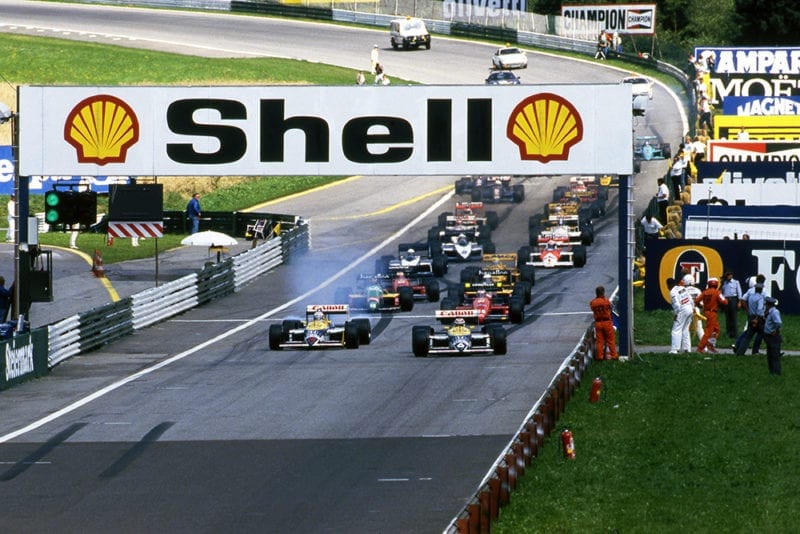
Nelson Piquet, Williams FW11B, and Nigel Mansell, Williams FW11B, lead at the start of the race.
© Motorsport Images
You don’t have to start much of a conversation going before opinions are expressed that in today’s list of Grand Prix circuits the ones which really impress people are Spa-Francorchamps, the Osterreichring, and our own Silverstone circuit. These are people, like myself, to whom Grand Prix racing is all about high-speed cornering — where absolute skills can be seen, and where lap records almost defy our imagination.
During a paddock conversation an ex-Grand Prix driver, who used to revel in high-speed circuits, was describing the handling of his new road car, a high-performance 4WD estate, and was giving a graphic description on its handling on a 100 mph curve. One of the group owned a similar car and the look of bewilderment on his face was lovely; you could see he had hardly ever had his car at 100 mph on a motorway, let alone round a long open corner on a normal road at that speed. As his description progressed, this fellow’s mouth was slowly opening wider and wider. Grand Prix drivers are a race apart, and though one or two may be a little apprehensive of the speeds reached on the Austrian circuit, none would willingly forego the Austrian Grand Prix and give his car to someone else.
But, to the serious business of practice, testing and qualifying on Friday. It was warm and dry, if a bit cloudy, and all seemed to be going well in the morning, with the two Williams-Hondas setting the pace as usual, When there was a loud jangling noise as Piquet’s car skated to rest along the pit wall.
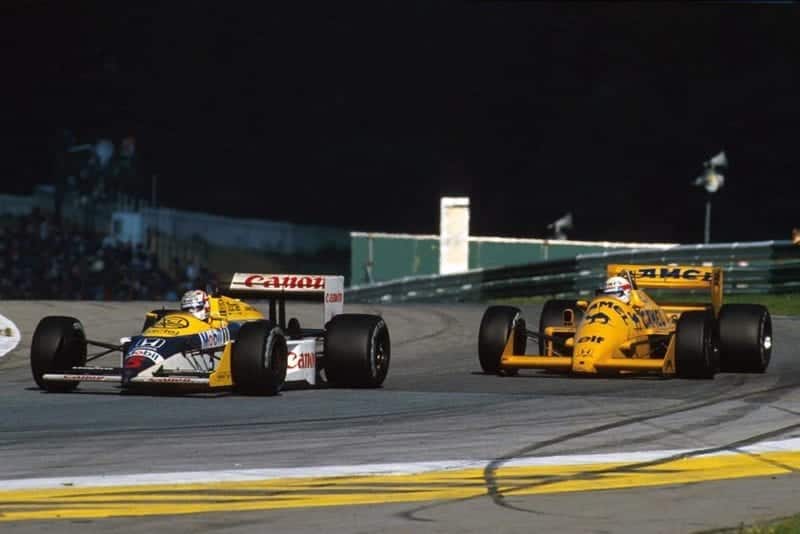
Nigel Mansell driving his Williams FW11B.
© Motorsport Images
He had come up on Pascal Fabre out of the very fast Rindt curve and clipped the AGS, tearing the left rear corner of the Williams quite badly. When you realise that the front-running turbocharged 11/2-litre cars are passing the pits at 195 mph, and the best of the non-turbocharged 31/2-litre cars were only doing 167 mph, you wonder why there are not more such collisions. Such is the constructional safety designed into Formula One cars today, that no-one was hurt and the mechanical damage could be repaired.
However, before the end of the morning there was another collision, and this time repair was out of the question. Just as Stefan Johansson came over the flat-out blind brow leading into the fast, dropping-away Rindt curve, a deer came out of the woods, jumped the safety fence and galloped across the track. The McLaren hit it fair and square, the left front corner of the car was ripped off, and Johansson curled himself up as the wreckage spun off into the guard rails and demolished itself. Bruised and shaken, the Swede climbed out of a totally written-off car. By the end of practice, when the wreckage was retrieved, many valuable bits had been pilfered by spectators, and McLaren International boss Ron Dennis read the riot-act to the organisers, especially when he discovered that the deer had been seen in the woods some time before the accident.
In the afternoon qualifying session, both Johansson and Piquet had to use their teams’ spare cars, and the battle for pole position on the grid began in earnest. Nelson Piquet may have announced his departure from the Williams team at the Hungarian Grand Prix, with effect from the end of the season, but it had no effect on his driving and he and Mansell were alone in vying for FTD.
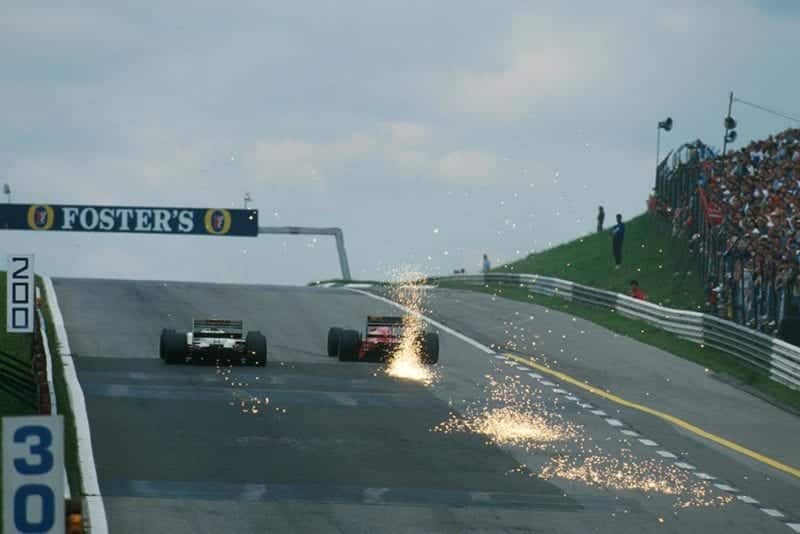
Cars bottom out going up the hill to Turn 1.
© Motorsport Images
On his home circuit, Gerhard Berger was rising to the occasion, and with Dr Harvey Postlethwaite back in charge of the team at the circuit, the Ferraris were looking good. Alboreto was not far behind, but between the two Ferraris were the Benetton-Fords of Boutsen and Fabi. No surprise this, because Rory Byrne’s cars were quick last year on this super-fast circuit, and their progress this year with Ford power has been improving steadily. Ayrton Senna with the Lotus “wonder-car” was simply not on the pace, and nor was Prost with the number one McLaren, his Porsche engine refusing to run cleanly. The overall picture was very much like Silverstone, with the slowest car, Faber’s AGS-Cosworth DFZ, clocking a maximum figure through the speed-trap at the start/ finish line, virtually equal to the average speed for the whole lap for the fastest man.
For a long time Mansell held the honour of being fastest, and it looked settled as he had his fuel tank filled right up with the idea of doing a lap or two to get the feel of the car at maximum weight. Piquet was still circulating in qualifying trim, and just as Mansell set off fully-laden Piquet snatched pole position from him.
The team told Nigel over his on-board radio and he came straight back into the pits, had all but a gallon or two pumped out, and screamed off down the pit lane to try to redress the situation. But time had run out, and the qualifying hour was over. A comedy like that makes you wonder about the management of the Williams team! The Williams part is self-explanatory, it is the defenition of the word “team” which is in question.
When everyone woke up on Saturday morning they knew it was all over, for the clouds were back down on the deck and the rain was pouring, which it continued to do until after mid-morning. Although the afternoon was dry and the sun came out just as the qualifying hour ended at 2pm, it was all too late and the starting grid was settled on Friday’s times.
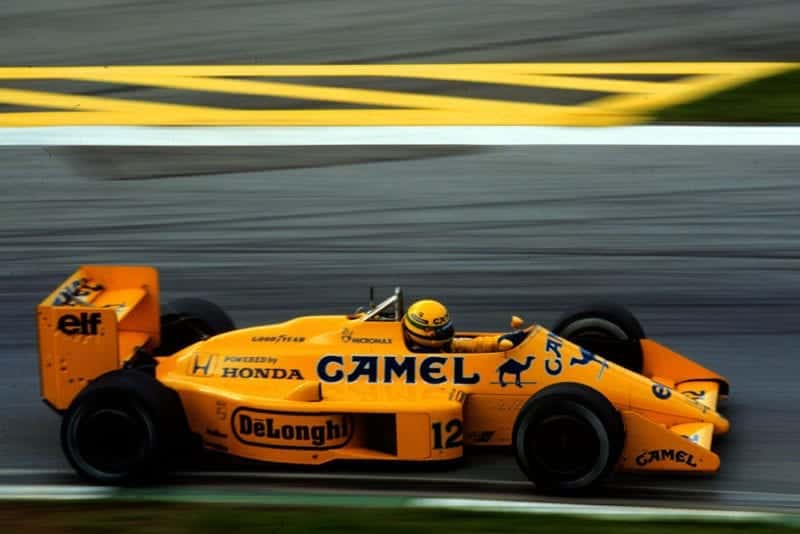
Ayrton Senna, Lotus Honda, finishes 4th.
© Motorsport Images
Not everyone went out on the wet track, some drivers preferring to stay in the pits; the Ligier team was forced to stay in due to a lack of Megatron-BMW upright 4-cylinder engines. There was a shortage at Heini Mader’s Swiss factory, with the Arrows team naturally having priority as it was its money from the Megatron finance firm which funded the whole engine enterprise.
For what it was worth, Mansell was fastest on the wet-and-dry track, but his time was ten seconds slower than he was capable of under perfect conditions. Piquet’s pole-position time from Friday was 1 min 23.357 sec, an average speed of 256.621 kph (159.457 mph), which was just a fraction faster than pole-position at Silverstone a month ago. If Saturday had been dry, there was every chance of the average speed passing the 160 mph mark — impressive, as the Osterreichring is as undulating as Silverstone is flat.
Race-day started off much better, and as the day progressed the weather improved, which was just as well for there were problems approaching which would not have been helped by more rain. The start was due at 2.30pm and after the morning warm-up period, in which there were one or two dramas demanding engine changes, Daimler-Benz AG put on a nice little demonstration recalling the “good old days”.
Hans Herrman drove a 1937 MercedesBenz GP car and Stirling Moss a 1955 GP car, which was nice to see as they were team-mates in the all-conquering Mercedes-Benz team of 1955. They made a fine sight as they passed the pits side-by-side, nothing like as fast as today’s Formula One cars, but characteristically quick.
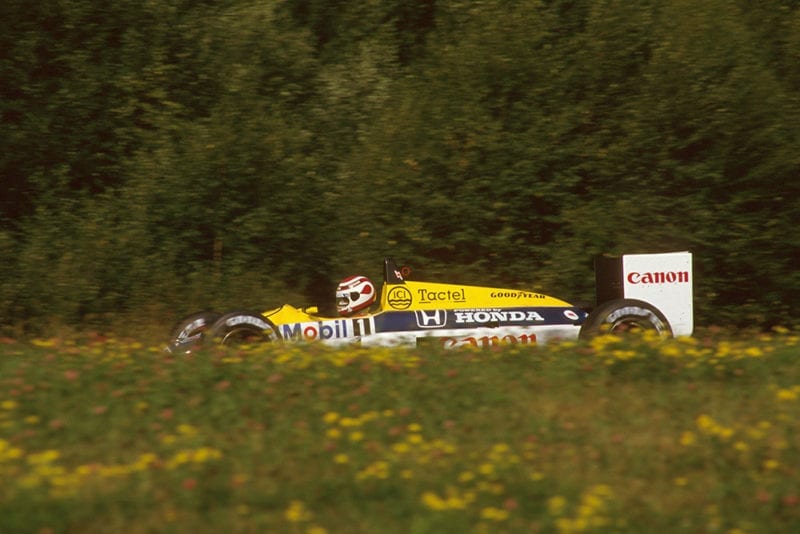
Nelson Piquet in his Williams FW11B Honda.
© Motorsport Images
When the pit-lane opened at 2pm all was more or less under control in readiness for the 52 lap race, apart from the Leyton House March team which had been forced into a quick engine change and was delayed by a broken throttle control, which meant Ivan Capelli was late onto the dummy-grid. The previous night a spare McLaren monocoque “tub” had arrived by Ford Transit van, driven flat-out, non-stop, Woking to Zeltweg in 24 hours, and now a complete spare car stood ready in the pit-lane garages, to replace the one written-off on Friday.
Piquet led the field round on the parade-lap, arriving back at the starting grid very slowly. The green light came on, and all twenty-six cars took off in a great rush at the steep hill which leads up to the first corner. As the tail-enders were half-way up the hill, Brundle’s Zakspeed suddenly turned sharp left and charged the barriers; while the leaders were on their way through the fast swerves to the far corner of the circuit, there were cars scattered all over the hill, and the race was aborted by the red flag at the start-line.
Those who had missed the melee on the hill stopped by the pits, and those who had wrecked their cars returned on foot to prepare the spare cars. Amazingly no-one was even bruised, but Brundle’s Zakspeed, Palmer’s Tyrrell and Ghinzani’s Ligier were hors de combat. Streiff’s Tyrrell was knocked about, but repairable, but Palmer had to take the T-car, as did Brundle and Ghinzani. Fuel tanks were topped up, tyres re-heated and everyone prepared to start all over again, after a suitable pause to get everything in order.
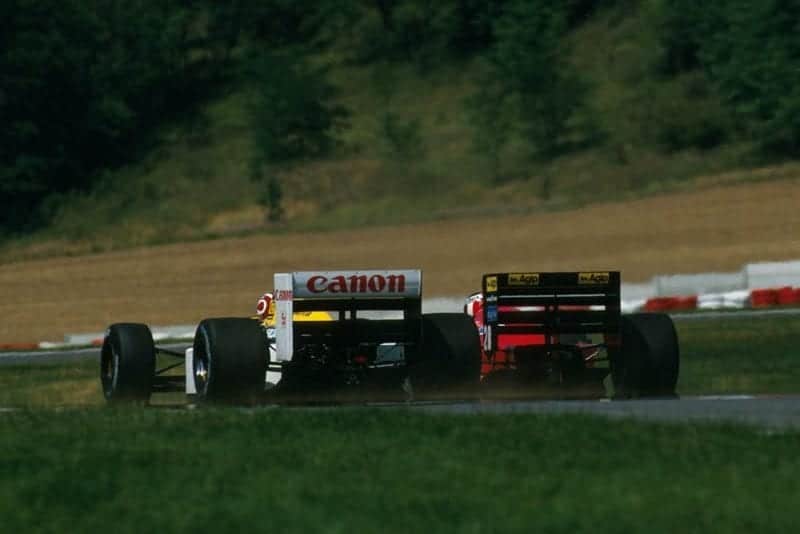
Nelson Piquet, Williams FW11B, and Gerhard Berger, Ferrari F1/87, battle.
© Motorsport Images
Once again Piquet led them slowly round on a parade-lap and once again the green light came on and everyone took off in another violent rush past the pits. This time Mansell cocked-up his start, like he had done in Germany, and the leading group roared away as Williams No 5 almost came to rest, with cars dodging by with mere millimetres to spare.
Inevitably it happened, just as the Williams-Honda gathered itself up and roared away. Nobody in the mid-field hit Mansell, but they all hit each other. The tail-enders had another melee, and once again the red flag came out. There wasn’t a bruise or a scratch, but there was mechanical carnage. Johansson’s McLaren, Cheever’s Arrows, Streiff’s Tyrrell, Caffi’s Osella and Ghinzani’s Ligier were all beyond repair; both Zakspeeds were bent but repairable, Alliot and Capelli changed to spare cars, and once more order was regained from chaos.
Ghinzani’s original Ligier was repaired, Cheever changed Arrows, Johansson took the brand new McLaren, Caffi set off in the spare Osella (but it expired soon after leaving the pits), Senna took the spare Lotus as his car had shattered a drive-shaft joint (nothing to do with the accident), and remarkably Streiff was the only one to have no further machinery available—along with Caffi’s expired Osella, this reduced the starters to 24.
Time was getting on, with television schedules and media deadlines in chaos, but regardless of this everyone formed up ready for another parade lap and a third attempt to start the Austrian GP. It wasn’t going to be easy. There were cars still being worked on in the pit lane and, as Piquet led the depleted grid away, Alain Prost was seen going slowly, his Porsche engine refusing to pick up properly. He crept across to the right and pulled into the pit-lane exit while the engine cleared itself, resigned to starting from the pit lane after everyone had gone by.
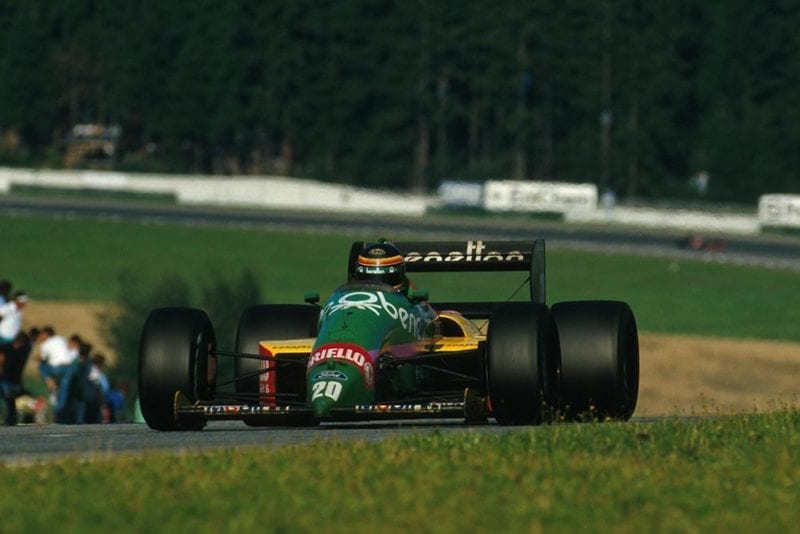
Thierry Boutsen in his Benetton B187.
© Motorsport Images
On the parade-lap Alboreto was seen to slow and then rush forward and pass cars, totally against the rules (remember John Watson being disqualified for doing this in South Africa?). As Piquet led the way slowly to the grid positions, Alboreto dived into the pits to have his steering wheel re-positioned on its splines; it had been put “on the bonk” which he found most disconcerting. This meant he had to join the queue waiting at the pit-lane exit, which included Prost, Cheever, Brundle, Fabre and Danner!
There were only eighteen cars on the grid this time, and there was a heart-stopping moment when the green light came on, as Senna stalled his Honda engine and remained stationary. Everyone missed him and when they had all gone the marshals push-started the Lotus. It took off in pursuit, with the Honda engine bouncing off the rev-limiter, as the pit-lane was given the all-clear to release the late-comers, led by Prost.
With a great sigh of relief everyone realized that at last the 1987 Austrian GP was under way. Piquet was leading, Boutsen a fine second in his Benetton, a fighting Berger third and a cautious Mansell fourth, followed by Fabi, Patrese, Warwick, de Cesaris, Johannson and Nakajima. Coming through from the back in no mean fashion were Prost, Senna and Alboreto, their progress being “purposeful” to say the least! Now the 52-lap race was really underway, it resolved itself in five groups: the bunch at the front which had kept out of trouble; the mid-field runners who were fairly healthy; the “walking-wounded” tail-enders; the non-turbocharged 31/2-litre group; and the “hard-chargers” who started with a handicap.
Up at the front Piquet was being harried impressively by Thierry Boutsen’s Benetton-Ford V6, Berger’s Ferrari had expired after only a handful of laps, and Mansell was weighing up the situation after his cautious start. Fabi, in the second Benetton was keeping pace with them.
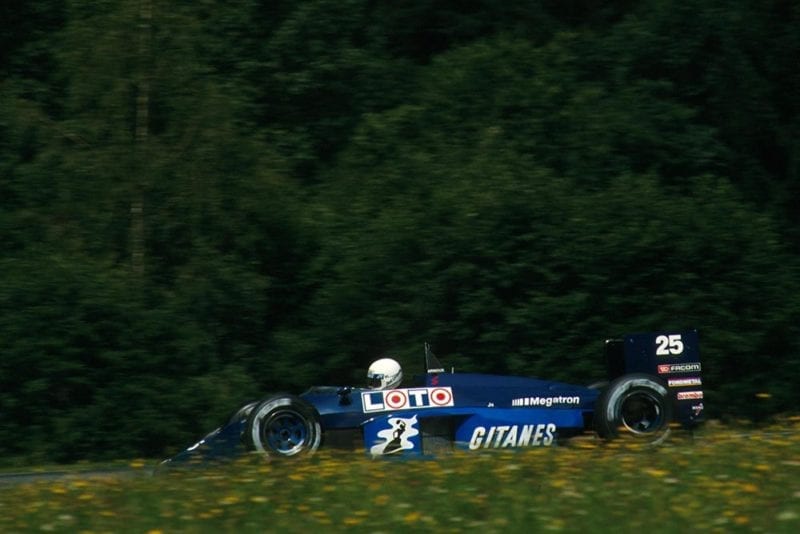
Rene Arnoux drives his Ligier JS29C.
© Motorsport Images
In the mid-field group Nakajima suffered a puncture and had to make a slow lap to the pits, but Patrese, Warwick and de Cesaris were going well. Capelli was leading the 31/2-litre group in the turquoise March-Cosworth, not far behind Ghinzani who was going well in his hastily-repaired Ligier.
From the back Prost, Senna and Alboreto were treating us to some ace driving as they climbed up the lap-chart.
Just before half-distance Senna had reached third place, Alboreto fourth, and Prost would have been sixth had he not stopped for new tyres on lap 24.
At the front the Williams team was dominant, Boutsen’s challenge fading when his gear linkage came loose and he had to make a pit stop. It was interesting that when he rejoined the race just ahead of the Williams on the road, but nearly a lap behind, he could comfortably match their lap speeds.
Piquet led until half-way round lap 21, when he was preparing to make a tyre stop; as he came up on some back markers he hesitated, and Mansell nipped by into the lead, a lead he would have taken anyway at the end of the lap. Piquet did not get back on the pace as quickly as he normally does, but when Mansell stopped for tyres on lap 25, his stop was two seconds quicker than his team-mate and he came back with a near-record lap. The outcome was that he maintained his lead during the stop and was never challenged from then on — Piquet settling for a safe second place, rather than fighting for the lead; a very uncharacteristic performance by the Brazilian.
As is becoming a habit, the two Williams-Honda cars had it all their own way, eventually lapping third-place man Fabi, who had been ousted from the position by Alboreto, by Senna and then by Prost. When Fabi came in for tyres he overshot the pit and had to go round for another lap and try again. Senna had been passed by Alboreto on lap 15, and though he got by when the Ferrari stopped for tyres, he made his own tyre stop a lap later, which put him behind again. Senna then began to have a go at the Ferrari, but came off second best when he rammed the red car up the backside, necessitating a slow lap and a pit stop for repairs.
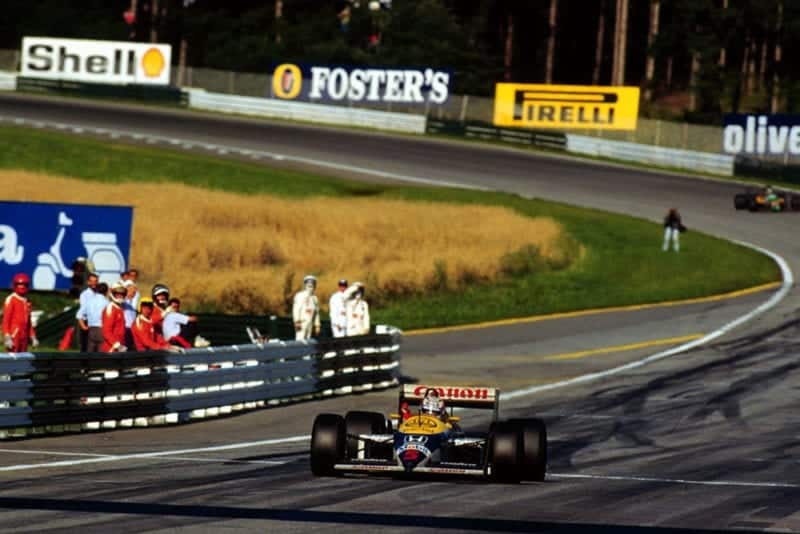
Nigel Mansell, raises his arm in victory at the Osterreichring.
© Motorsport Images
Prost meanwhile had got the better of both of them and was comfortably in third place, only to have his Porsche engine go on the blink with only ten laps to go. Although the World Champion was able to nurse the car along to the finish, he was lapped by the Williams pair and passed by Fabi, Boutsen and Senna, to finish sixth. It was a bad weekend for McLaren International, for Johansson’s practice crash had destroyed the car, the newly-built car was badly damaged in the second start accident, and Prost lost a secure third place.
To cap the lot, Johansson got an unexpected puncture early in the race and limped to the pits for new tyres, whereupon Ron Dennis gave him the signal to go before the mechanic on the right front wheel had finished. The result was the mechanic was knocked over and injured and Johansson went off with the wheel-nut loose.
The wheel flew off and he completed the lap on three wheels, returning to the pits to try again. After that he drove a good race to finish seventh, but Ron Dennis was not too popular, even though he is the boss-man! Stefan Johansson must have been glad when the weekend was over.
Probably as a result of Senna’s “nudge”, Alboreto’s Ferrari suffered a broken exhaust system which affected the engine power, and he was forced out after an enterprising run and a Ferrari performance more like we expect. Senna finished a rather unsatisfactory fifth, behind the two Benettons, which had menaced “the establishment” all weekend.
The race finished very late, as can be imagined, but it was a beautiful Austrian evening and as the sizeable crowd made its way home it was probably a bit bewildered by it all. It had certainly had its fair share of excitement, though much of it we could have done without.
Some of the officials and the international media tended to blame both accidents on the narrowness of the starting area, which was quite unjustified. The first accident was well beyond the start-line area, and could just as easily have happened on the second or third lap. The second accident was indeed a product of the lack of escape areas past the pits, and was provoked by a cocked-up start by a driver who did not get involved.
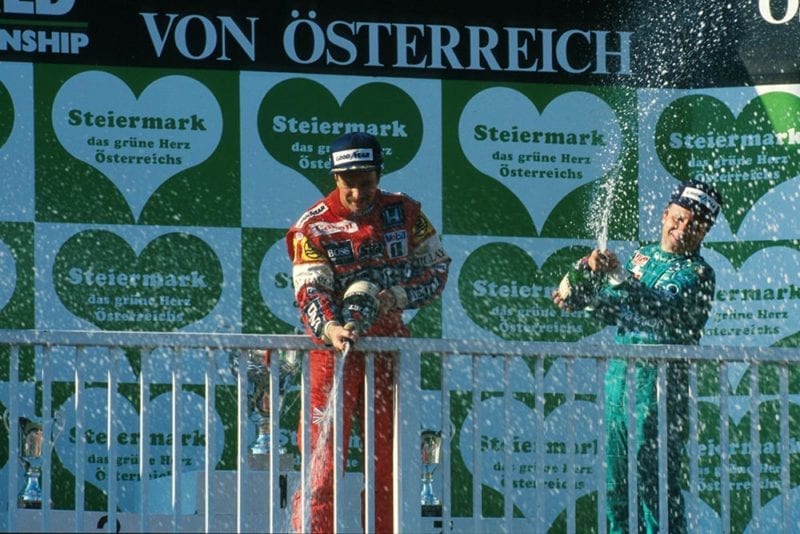
Winner Nigel Mansell and 3rd place Teo Fabi celebrate on the podium.
© Motorsport Images
One top FISA official was heard to blame all the drivers out of hand, for not using their brains. I would suggest that Frank Williams let him have a go in an FW11B, and we’ll watch him make a racing start at the Osterreichring, or anywhere else, and see how he gets on without any other cars on the stack. Then try and imagine what it must be like to be in amongst a crowd of twenty-six racing drivers, all of them tensed up and raring to go.
My friend Paddy Machonogee says he has the answer to first-lap accidents. He tells me that in Eire they start races on lap two, because first laps are too dangerous! DSJ
